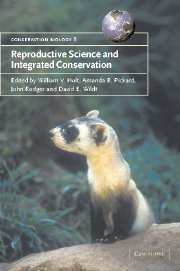Book contents
- Frontmatter
- Contents
- List of contributors
- Foreword
- Part I Introduction
- Part II Reproduction and population viability
- Part III Reproductive techniques for conservation management
- 9 Reproductive and welfare monitoring for the management of ex situ populations
- 10 Non-invasive endocrine measures of reproduction and stress in wild populations
- 11 Ultrasound for analysis of reproductive function in wildlife species
- 12 Role of embryo technologies in genetic management and conservation of wildlife
- 13 Application of nuclear transfer technology to wildlife species
- Part IV Integrated conservation management
- Part V Reproduction science in non-mammalian species
- Part VI Conclusions
- Index
- References
13 - Application of nuclear transfer technology to wildlife species
Published online by Cambridge University Press: 21 January 2010
- Frontmatter
- Contents
- List of contributors
- Foreword
- Part I Introduction
- Part II Reproduction and population viability
- Part III Reproductive techniques for conservation management
- 9 Reproductive and welfare monitoring for the management of ex situ populations
- 10 Non-invasive endocrine measures of reproduction and stress in wild populations
- 11 Ultrasound for analysis of reproductive function in wildlife species
- 12 Role of embryo technologies in genetic management and conservation of wildlife
- 13 Application of nuclear transfer technology to wildlife species
- Part IV Integrated conservation management
- Part V Reproduction science in non-mammalian species
- Part VI Conclusions
- Index
- References
Summary
INTRODUCTION AND OBJECTIVES
Nuclear transfer (i.e. cloning) is the process whereby the nuclear DNA of a single donor cell is transferred to an enucleated oocyte that, in turn, is activated to produce an embryo which is genetically identical to the original donor cell. Advances in cell and reproductive biology have made the practical application of nuclear transfer theoretically feasible for propagating rare animal species (Campbell et al., 1996; Wilmut et al., 1997; Wakayama et al., 1998, 2000; Wakayama & Yanagimachi, 1999a, b; Colman, 2000; Lanza et al., 2000a). Following successful nuclear transfer in the sheep and the mouse to produce surviving young, a calf from a wild cattle species (Bos gaurus) has been produced using nuclear transfer and interspecies embryo transfer (Lanza et al., 2000c). Although it is premature to declare whether nuclear transfer has practical application to wildlife species management or conservation, general interest in this technology is intense, thereby warranting serious and thoughtful consideration. This chapter offers an evaluation of nuclear transfer, distinguishing between what is technically possible, realistic and ethical.
State of the art
Technological realities of using nuclear transfer
There is an array of factors limiting the technical feasibility of using nuclear transfer as a routine method of propagating animals, domestic or wild.
Reprogramming the nucleus
Most cells in an animal are genetically identical. Theoretically, each cell's nucleus contains the entire blueprint for that organism, and genes are expressed differentially to construct and maintain the various tissues.
- Type
- Chapter
- Information
- Reproductive Science and Integrated Conservation , pp. 195 - 208Publisher: Cambridge University PressPrint publication year: 2002
References
- 2
- Cited by

